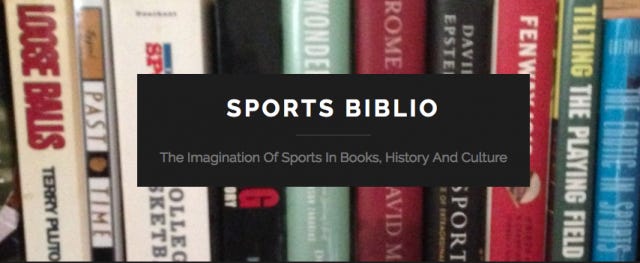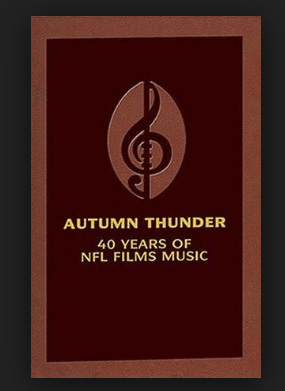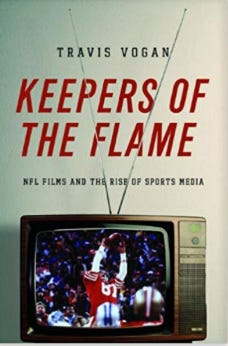Sports Biblio Digest 7.29.18: The Symphonic Football Soundtracks of Sam Spence

News, Views and Reviews About Sports Books, History and Culture
In This Issue: The New York Daily News; Kirk Gibson; Dale Murphy; Satchel Paige and Rafael Trujillo; Imran Khan; The Future of Aussie Rules; The Faith of Jackie Robinson; Vintage Boxing Cards at the Met
* * * * * * * *
The sound of NFL Films could very likely have been more like a 1950s television comedy show than the Western-infused, movie-style orchestral soundtracks of the 1960s that Sam Spence crafted.

Spence was living in Munich in the early 1960s, writing music for German television programs, when he was brought into a new project by a friend whose musical themes were customized for the titans of American comedy, namely Jack Benny.
Mahlon Merrick, also the creator of the "Look Sharp/Be Sharp March" for the popular Gillette Cavalcade of Sports program in the 1950s, had a busy schedule, and asked Spence to help create music for the initial documentaries Ed Sabol was producing for the NFL.
It wasn’t planned, but Spence stuck some orchestral pieces he had written near the end of the editing process. Sabol liked what he heard so much he offered Spence a three-year contract, and one of the most distinctive sports-and-arts collaborations was born.
For 24 years, as the NFL ascended to the top of the spectator sports heap in America, Spence composed around 700 pieces of music for NFL Films.They were as ubiquitous as the aura that was building around NFL Films, with its lush 16-millimeter color film cinematography and the dulcet baritone narration of John Facenda.
If Facenda was the “Voice of God,” Spence’s accompaniments quite often took on their own luster.
“The Over the Hill Gang,” “Pony Soldiers,” “Classic Battle” and “Autumn Wind” are among his more memorable compositions, utilizing a 65-piece orchestra and influenced by the work of film composers Bernard Herrmann, Erich Korngold and Miklos Rosza.

In “Keepers of the Flame,” his 2014 book about NFL Films, Travis Vogan wrote that Spence’s work “placed the sport into a cinematic register.”
“The Magnificent Eleven” was a direct spinoff from the Hollywood film “The Magnificent Seven.” Vogan wrote how Spence and Sabol worked together, across a vast ocean:
“The composition process was unorthodox in its simplicity. Sabol would phone Spence in Munich and literally hum him a few bars. Spence would then transform Spence’s templates into full-bodied orchestrations that often combined booming bass drums and driving timpani with French horns, oboes and flutes.”
After Spence’s death on the eve of Super Bowl L in 2016, it was noted that in “Round Up,” another of his notable works, “the featured use of brass melodies and the timpani reflects the excitement of an old fashioned cattle drive, coupled with the nature of NFL linebackers tracking down and wrapping up offensive players like wild bulls.”
Ed Sabol explained his choice of Spence this way:
“I wanted music that would speak to the passion of the game and that would also be contemporary. Sam took hummable melodies, like British drinking songs, Irish ballads and Israeli wedding music, and updated them.”
If Spence knew how to deliver what Sabol and his son Steve Sabol wanted, the composer found dealing with the NFL in his later tenure difficult and bitter.
His work for NFL Films ended in 1990, and he told Film Score Monthly magazine in a 2013 article that he twice felt duped by the NFL in signing away royalty rights.
Spence was invited to conduct performances of his works late in his life, including his first-ever trip to Lambeau Field in Green Bay in 2011 and a performance with the Green Bay Civic Symphony. As he explained before his visit there:
“Writing music is like writing a letter You get the idea in your head and you write it down. You hear it and you write it down.
“I never wrote background music. That was the great thing about writing for the NFL. I wrote foreground music I wrote pieces of music that people could sing and it would stick in the ear.”
His music also was featured on EA Madden NFL video games in the aughts.
Spence was 88 when he died the day before one of the more memorable Super Bowls in history, as the New England Patriots came back from a 28-3 deficit to defeat the Atlanta Falcons. Said his son Kim:
"He lived to hear from people who enjoyed his work. He believed his music would allow him to live forever."
This concludes our July newsletter series about Classic Creators. Previous lead topics were Red Smith, Robert Riger and LeRoy Nieman.
Coming in August: The newsletter will feature an (American) football bookshelf series, including biographies of Brett Favre and Terry Bradshaw, what high school football means in a declining town in western Pennsylvania, and pigskin politics.
The series starts next week with Mark Kram Jr., and his award-winning 2012 book “Like Any Normal Day: A Story of Devotion.”
Cooperstown Weekend
When Kirk Gibson, 61, is inducted in the Baseball Hall of Fame Sunday, it will come 30 seasons after his famous home run in Game 1 of the World Series. At Sports Illustrated, S.L. Price writes about Gibson’s battles with a volcanic temper that soured his dealings with many people in baseball and his life away from the game;

Wright Thompson goes long on a player many fans (myself included) think should be in Cooperstown: Dale Murphy, a two-time National League MVP who hit 398 home runs and juggled his career with being a Mormon father to eight children;
Murphy’s Braves descendent, Chipper Jones, may have some family juggling issues of his own Sunday. He’s slated to join Gibson, Jack Morris, Vladimir Guerrero, Trevor Hoffman, Jim Thome and Alan Trammell in Cooperstown, but his wife is expecting a baby at the same time. She traveled to upstate New York and delivery arrangements have been made at a local hospital just in case. Regardless of where the child is born, Jones’ sixth son will be named Cooper.
Sports Media News
Massive layoffs at The New York Daily News this week have absolutely gutted the sports department. While my friend and Mets beat writer Kristie Ackert has been spared, Mark Mazzeo, her counterpart on the Yankees beat, was not. Also gone are Knicks writer Frank Isola, columnist John Harper and writers Christian Red, Peter Botte and Kevin Armstrong.
An award-winning contingent that previously included Mike Lupica, Bill Madden, Filip Bondy and Gary Myers not all that long ago is down to nine staffers. As in one less than 10.
The total newsroom size is now around 40, down from around 85, as Tronc greedmongers indulge in another bloodbath, stripmining what’s left of a feisty tabloid that has covered local news and sports with real passion since its founding 99 years ago.
What was proudly dubbed “New York's Picture Newspaper” laid off its entire photography department. The paper that once upon a time featured the byline of the incomparable Pete Hamill dispensed with its top two editors.
Former Daily News staffer Michael Kay sounded off on Tronc on his popular New York radio program. Even the rival tabloid New York Post offered condolences: “We want to beat the News, but not like this.”
After purchasing the paper from Mortimer Zuckerman last year for the princely sum of $1, Tronc has more than proven itself to be as incompetent as it is greedy.
Sadly, the corporate raiding that hit Manhattan this week is taking place everywhere. The vultures swoop down on dying industries all the time, and this one is no different.
Yes, it is capitalism at work, and ultimately, it’s going to be up to journalists, working with their communities, who will have to revive local news. For far too long, the newspaper industry refused to innovate and embrace change as it should have. I observed this right away when I switched to digital news 15 years ago.
What’s been lost is not coming back. I’m gutted for those who’ve lost their livelihoods and hope for the best for those who still put up the good fight.
As The Athletic continues to expand (recently adding David O’Brien and Jeff Schultz, two of my former Atlanta J-C colleagues), the sports media landscape that sustained my generation is being swept away faster than I ever imagined.
I left newspapers 10 years ago, and haven’t spent much time looking over my shoulder. It’s about building what’s next, as quixotic as that seems.
But no matter how many times I hear bad news like this, even on a much smaller scale, it still hurts so much to absorb even more.
A Few Good Reads
Media historian Michael Socolow noted this week that it was the Daily News that revolutionized the daily sports section, as big-city papers expanded in the 1920s, flush with Jazz age advertising. Headlining the sports coverage was Paul Gallico, and Socolow unearthed “My Fight With Jack Dempsey,” which was published in 1937, the year after he left newspaper work and turned to fiction;

The author of a new book on Australian Rules Football ruminates on its future amid demographic changes that may elevate other sports to greater popularity;
Satchel Paige’s baseball days in the Dominican Republic, playing for a team sponsored by dictator Rafael Trujillo, are the subject of a new book whose author appeared recently at the Scholars Symposium at the March On Washington Film Festival in Washington;
Imran Khan is Pakistan’s most decorated cricketer ever, and his international career culminated with the nation’s only World Cup crown in 1992. But in the aftermath of his controversial election as the new Pakistani prime minister, concerns abound about whether he’s up to such a daunting task;
In the English midlands, minority cricketers are playing everywhere on the recreational level, but are they being discovered for high-level competition?;
Two new books about the faith of Jackie Robinson are out, and delve into a long-overdue subject, Paul Putz writes in Christianity Today;
When medical interventions in sports cross the line is as delicate a subject as where those lines should ideally be drawn;

The work of sports psychologist Ken Ravizza lives on, although the Chicago Cubs are deeply feeling his recent passing. The Cal State Fullerton professor and mental skills coach was credited with guiding the club as it ended the franchise’s 108-year World Series drought in 2016. Ravizza was the author of “Heads-Up Baseball” and 2.0 edition;
On July 2 the latest exhibition of sports cards from the Jefferson R. Burdick collection at New York’s Metropolitan Museum of Art opened. “On the Ropes: Vintage Boxing Cards” features nearly 300 objects from the 1880s to the 1950s, and will be shown until Oct. 21. Artists whose works are depicted include Richmond Barthé, George Bellows, Lola Cueto, Edweard Muybridge and August Sander.
Off the Sporting Green
Some interesting non-sports reads to leave you with in this last issue of what’s been a very hot July:
The hit international TV series “Babylon Berlin,” based on the Gereon Rath detective mystery series, is getting good reviews for its stylish presentation and well-rounded historical depiction of the Weimar age;
More than 32,000 objects from the Bauhaus Movement that emerged during Weimar have been put online by the Harvard Art Museums;

The appalling case of Otto Warmbier, an American college student detained, beaten and held hostage by the North Korean government, which released him right before he died upon his return home to Ohio;
“Ideologically, it’s a mess. Culturally, it’s coherent.”—What Democrats don’t get about the South;
In Luverne, Ala., in the deepest regions of the Bible Belt, evangelical Christians try to reconcile their faith and morality with their support for President Donald Trump;
A spoof social justice warrior on Twitter was a work of satirical brilliance;
More on social media mobbing by a former Twitter and Facebook mobster who believes that it's only after snapping out of virtue-signalling and seeing “the world as it really is, and people as they really are, that we appreciate the destruction and human suffering we caused when we were trapped inside;”
Why a reporter for The New York Times who covers Trump is curtailing her use of that platform, and it has nothing to do with the Tweeter-in-Chief;
Franklin Foer, author of a recent jeremiad against the tech giants, heavily references John Milton’s “Areopagitica” in asserting that Facebook, Google and their ilk are enemies of free expression;
Could reviving civic engagement in our communities be as simple as joining local groups like the Rotary Club?;

New Harvard research explains why we’re so conflicted about the progress of our age;
Power alone does not explain the abusive behavior of Harvey Weinstein, Kevin Spacey, James Levine and other men who sparked the “Me Too” movement;
I never get tired of lists of bucket-list book stores, especially since I’ve been to only one of these and likely won’t get to any of the rest;
American-born, London-based novelist Lionel Shriver is unrepentant in her battle against those who accuse her of cultural appropriation, calling their broadsides an existential attack on the freedom of the artist:
“The solution is not to place a fence around everybody. We are putting together a version of the world that is false.”
* * * * * * * *
The Sports Biblio Digest is an e-mail newsletter delivered each Sunday. You can subscribe here and search the archives.
This is Digest issue No. 133, published July 29, 2018.
I’d love to hear what you think about the Digest, and Sports Biblio. Send feedback, suggestions, book recommendations, review copies, newsletter items and interview requests to Wendy Parker at sportsbiblio@gmail.com.
You can also follow Sports Biblio on Twitter and hit the “like” button on Facebook.


